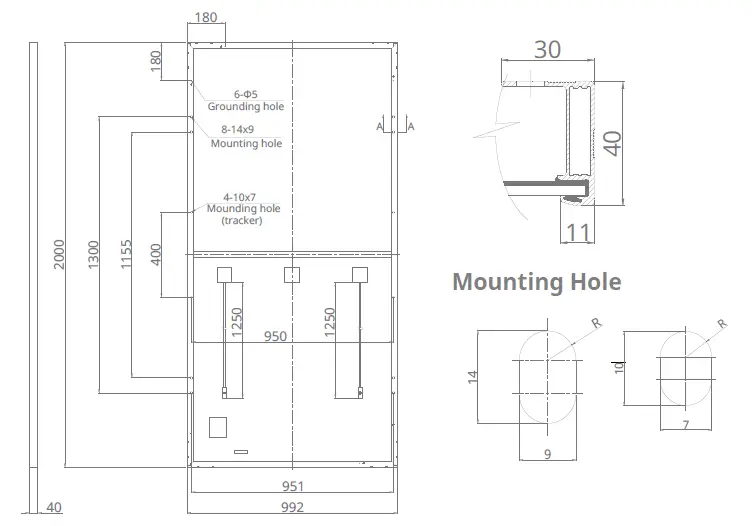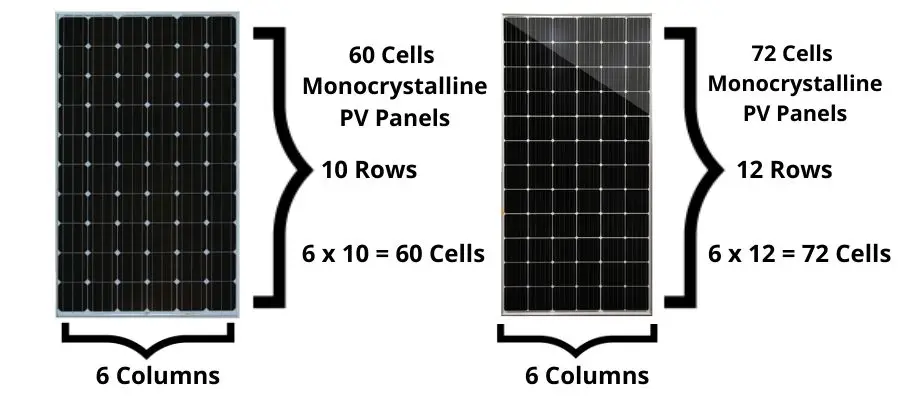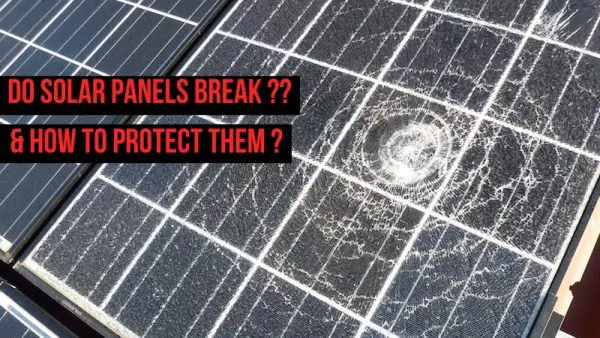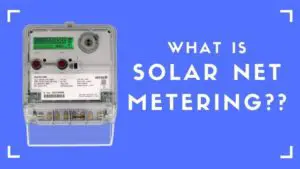The physical size and weight of a solar panel depends on the cell configuration (60 cells, 72 cells) and the wattage of the solar panel. In this article we will see what is the standard size of a solar panel and weight of a solar panel.
The standard size of a 250 Watt 60 cell solar panel be it monocrystalline or polycrystalline is 39 inch X 66 inch (3.25 ft X 5.5 ft) and the weight of a 250 watt 60 cell solar panel is around 19 kg.
Whereas the size of a 320 watt 72 cell solar panel is 39 inch X 77 inch (3.25 ft X 6.42 ft) and the weight of a 300 watt 72 cell solar panel is around 25 kg.
Before we start with the size of solar panels it is imperative to know construction of a solar panel. A typical solar panel is made up of solar cells which are arranged in rows and columns to form a solar panel.

More the number of solar cells, larger is the size of solar panel and thus heavier is the solar panel.
Standard Size Of Solar Panels & Weight of Solar Panels:

As I said before every solar panel is made by connecting solar cells in series and parallel arrangement.
The standard size of a solar cell is 156 mm X 156 mm (approx. 6 inch X 6 inch).
For a 60 cell solar panel the cell arrangement is 6 X 10 (6 columns and 10 rows) and for a 72 cell solar panel cell arrangement is 6 X 12 (6 columns and 12 rows).
The standard size of a solar panel is:
- The size of a solar panel with 60 cell configuration is 39 inch X 66 inch (3.25 ft X 5.5 ft).
- The size of a solar panel with 72 cell configuration is 39 inch X 77 inch (3.25 ft X 6.42 ft).
- The thickness of a 60 cell or 72 cell solar panel is around 40mm.
The standard weight of a solar panel is:
- The weight of a 60 cell solar panel is 19 kg.
- The weight of a 72 cell solar panel is 25 kg.

Below you will find data about size an weight of solar panels from popular brand like Vikram solar, Canadian solar, Trina solar, Jinko solar, Waaree solar.
Size And Weight of 60 Cell 250 Watt Solar Panel:
| Solar Panels | Size | Weight |
|---|---|---|
| Canadian solar CS6K | 1650 X 992 X 40 mm | 18.2 kg |
| Vikram Solar Eldora Neo Series | 1640 X 992 X 40 mm | 18.5 kg |
| Waaree Solar 250W | 1640 X 990 X 40 mm | 22.5 kg |
| Trina Honey Series | 1650 X 992 X 35 mm | 18.5 kg |
| Jinko Solar Panels 255W | 1650 X 992 X 40 mm | 19 kg |
Size And Weight of 72 Cell 300 Watt Solar Panel:
| Solar Panels | Size | Weight |
|---|---|---|
| Canadian solar Dymond Series | 1968 X 992 X 58 mm | 27.5 kg |
| Vikram Solar Eldora Grand Series | 1955 X 991 X 40 mm | 22 kg |
| Waaree Solar Aditya Series | 1960 X 990 X 40 mm | 22.5 kg |
| Trina Tall Max Series | 1956 X 992 X 40 mm | 22.5 kg |
| Jinko Solar Panels | 1956 X 992 X 40 mm | 26.5 kg |
Solar panels smaller than 250 watts have even smaller size, but they are not used for household or industrial application hence I have not shared their dimensions.
Now that you know the size and weight of a solar panel, let’s see how much area is needed to install these panels and can you roof sustain these solar panels weight.
How Much Rooftop Area is Needed To Install Solar Panels:
On an average the size of all the solar panels which are more than 300 watt is 2m x 1m (6.5 ft. x 3.25 ft.) and the area is 2 sq.m or 21.50 sq.ft.
So to calculate the rooftop area required for installing solar panels use the following equation.
Area required for solar panels = Total number of solar panel x area of one panel
For example for a 7.5 kW system has 23 solar panels each of 320 watts which means area needed to install 7.5 kW of solar panels is,
Area for 7.5 kW of solar panels = 23 x 21.50 = 495 sq.ft
This is just the area required to mount all the solar panels back to back and side by side to each other.
In real life we have to leave walking space between rows and columns of solar panels so that we can easily clean the solar panels every now and then, and also have safe access to perform maintenance if and when needed.
You can use the below table to get a rough idea of how much rooftop area solar panels will cover.
| Solar System Size | No Of PV Panels (330 W Each) | Area Required |
|---|---|---|
| 1 kW Solar System | 3 | 65 sq.ft – 90 sq.ft |
| 2 kW Solar System | 6 | 145 sq.ft – 180 sq.ft |
| 3 kW Solar System | 9 | 205 sq.ft – 270 sq.ft |
| 5 kW Solar System | 12 | 285 sq.ft – 450 sq.ft |
| 8 kW Solar System | 25 | 580 sq.ft – 720 sq.ft |
| 10 kW Solar System | 30 | 750 sq.ft – 900 sq.ft |
Note: Considering cleaning space and access for troubleshooting we can assume to install 1 kW of solar system on a metal roof we need 85 sq.ft of shadow free area.
Note: Considering cleaning space and access for troubleshooting we can assume to install 1 kW of solar system on your RCC you will need 100 sq.ft of shadow free area.
I Don’t Have Enough Area To Install Solar Panels What Should I Do?
If your house requires 7 kW system but your area permits to install only 5 kW, then try using bigger wattage solar panels like 380 watt, 400 watt or use monocrystalline solar panels as they are more efficient than polycrystalline solar panels and produce more power in the same area.
However switching to monocrystalline and bigger wattage panels will increase your overall solar system cost by 10-20%.
Will My Structure Be Able To Sustain Weight of Solar Panels:
As seen above the average weight of a 330 watt solar panel is 25 kg and size is close to 2 m X 1m (6.5 ft x 3.25 ft).
After considering the weight of mounting structure the total weight of one solar panel will be 30 kg at max for roof mounted system (Metal shed or asbestos) and 35 kg at max for a RCC mounted system (terrace).
This means the maximum weight on per square feet area of your metal or asbestos roof will be less than 1.6 kg.
and the maximum weight on per square feet area of your RCC roof (terrace) will be less than 1.8 kg.
I think most metal shed and RCC roof can sustain this much load but if you have an asbestos or cement roof then you should change it, since solar panels have warranty of 25 years and shelf life of over 30 years but an asbestos roof won’t last for such long time.
To know more on this read this article Can I install solar panels on asbestos roof?
If you have any confusion on whether your roof can sustain this weight then contact your near by solar installer and ask for a site visit they can help you out with this.
Conclusion:
The average size of above 330 watt solar panel is 2 meter X 1 meter ( 6.5 ft X 3.25 ft ) and weight is approximately 25 kg.
The surface area of a 330 watt solar panel is 21 sq.ft and the maximum weight exerted by solar panels on your roof is 1.8 kg. per square foot.
Feel free to share this article on WhatsApp, Facebook, Reddit and also add relevant comments related to the size and weight of solar panels.
Thank You 🙂
References:
- https://www.canadiansolar.com/in/solarPanels/detail/22
- https://www.vikramsolar.com/download-category/data-sheets/
- https://www.waaree.com/pv-module
- https://www.trinasolar.com/
- https://www.jinkosolar.com/






Nice work.
Thank you Jay, Glad you liked it 🙂
This article provides details about what is the size of a solar panel weight of a solar pane. This blog happens to be one of the best blogs, which give proper details about it. I enjoyed reading this blog and would suggest others too, and you would get to read about it in this link.el/ Come across https://www.roofcleaningmiami.net/ and hope you can visit this too to get more information.
what will happen when we fix on Boats,
how frequently we can clean the solar panel
my area available will be 24 meters x 7 meters
what will be weight when I use 370 watts panel for 27 kilowatts requirement.
boat is driven by solar power
The weight of one 370 watt solar panel is around 25 kg, so far 27 kW you will need 72 solar panels, which will around 1.8 tons.
But from the area which you have mentioned (24 meters X 7 meters = 1700 sqft), you can install up to 18kW at max.
And about the cleaning part, it totally depends on the dust accumulation on top of it.